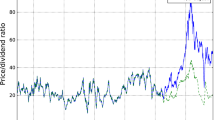Abstract
This chapter introduces the agent-based modeling methodology and points out the strengths of this method over traditional analytical methods of neoclassical economics. In addition, the various design issues that will be encountered in the design of an agent-based financial market are discussed.
Access this chapter
Tax calculation will be finalised at checkout
Purchases are for personal use only
Similar content being viewed by others
References
Arthur, W.B. 1994. Inductive reasoning and bounded rationality. American Economic Review 84 (2): 406.
———. 1999. Complexity and the economy. Science 284 (5411): 107.
Audet, N., Gravelle, T., and Yang, J. 2001. Optimal market structure: Does one shoe fit all? Technical report, Ottawa: Bank of Canada.
Batten, D.F. 2000. Discovering artificial economics: How agents learn and economies evolve. Boulder: Westview Press.
Chen, S.-H., and C.-H. Yeh. 2001. Evolving traders and the business school with genetic programming: A new architecture of the agent-based artificial stock market. Journal of Economic Dynamics and Control 25: 363–394.
Duffy, J. 2006. Agent-based models and human subject experiments. In Handbook of computational economics volume 2: Agent-based computational economics, Handbooks in Economics Series, ed. K.L. Judd and L. Tesfatsion. Amsterdam: Elsevier North-Holland.
Farmer, J.D., and Joshi, S. 2000. The price dynamics of common trading strategies. Santa Fe Institute Working Paper 00–12-069, Santa Fe, New Mexico.
Gode, D.K., and S. Sunder. 1993. Allocative efficiency of markets with zero intelligence traders. Journal of Political Economy 101: 119–137.
Grossman, S.J. 1976. On the efficiency of competitive stock markets where traders have diverse information. Journal of Finance 31 (2): 573.
Hommes, C.H. 2006. Heterogeneous agent models in economics and finance. In Handbook of computational economics volume 2: Agent-based computational economics, Handbooks in economics series, ed. K.L. Judd and L. Tesfatsion. Amsterdam: Elsevier North-Holland.
Johnson, N.F., D. Lamper, P. Jeffries, M.L. Hart, and S. Howison. 2001. Application of multiagent games to the prediction of financial time-series. Physica A 299: 222–227.
LeBaron, B., W.B. Arthur, and R. Palmer. 1999. Time series properties of an artificial stock market. Journal of Economic Dynamics and Control 23 (9, 10): 1487–1516.
LeBaron, B. 2000. Agent-based computational finance: Suggested readings and early research. Journal of Economic Dynamics and Control 24 (5–7): 679–702.
———. 2001a. Empirical regularities from interacting long and short memory investors in an agent-based stock market. IEEE Transactions on Evolutionary Computation 5: 442–455.
———. 2001b. Evolution and time horizons in an agent-based stock market. Macroeconomic Dynamics 5 (2): 225–254.
LeBaron, Blake. 2001c. A builder’s guide to agent-based financial markets. Technical report, International Business School, Brandeis University, Waltham.
LeBaron, B. 2006. Agent-based computational finance. In Handbook of computational economics volume 2: Agent-based computational economics, Handbooks in economics series, ed. K.L. Judd and L. Tesfatsion. Amsterdam: Elsevier North-Holland.
Parunak, H., Savit, R., and Riolo, R.L. 1998. Agent-based modeling vs. equation-based modeling: A case study and users’ guide. In Multi-agent systems and agent-based simulation, ed. MABS, C. Sichman, and Gilbert. Berlin: Springer.
Rescher, N. 1980. Induction: An essay on the justification of inductive reasoning. Pittsburgh: University of Pittsburgh Press.
Tay, N.S.P., and S.C. Linn. 2001. Fuzzy inductive reasoning, expectation formation and the behavior of security prices. Journal of Economic Dynamics and Control 25 (3, 4): 321–361.
Tesfatsion, L. 2002. Agent-based computational economics: Growing economies from the bottom up. Artificial Life 8 (1): 55–82.
Author information
Authors and Affiliations
Corresponding author
Editor information
Editors and Affiliations
Rights and permissions
Copyright information
© 2022 Springer Nature Switzerland AG
About this entry
Cite this entry
Tay, N.S.P. (2022). Agent-Based Models of Financial Markets. In: Lee, CF., Lee, A.C. (eds) Encyclopedia of Finance. Springer, Cham. https://doi.org/10.1007/978-3-030-91231-4_41
Download citation
DOI: https://doi.org/10.1007/978-3-030-91231-4_41
Published:
Publisher Name: Springer, Cham
Print ISBN: 978-3-030-91230-7
Online ISBN: 978-3-030-91231-4
eBook Packages: Economics and FinanceReference Module Humanities and Social SciencesReference Module Business, Economics and Social Sciences




